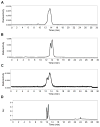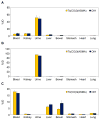Preclinical evaluation of 99mTc(CO)3-aspartic-N-monoacetic acid, a renal radiotracer with pharmacokinetic properties comparable to 131I-o-iodohippurate
- PMID: 22717977
- PMCID: PMC4064304
- DOI: 10.2967/jnumed.111.102236
Preclinical evaluation of 99mTc(CO)3-aspartic-N-monoacetic acid, a renal radiotracer with pharmacokinetic properties comparable to 131I-o-iodohippurate
Abstract
In an ongoing effort to develop a renal tracer with pharmacokinetic properties comparable to p-aminohippurate and superior to those of both (99m)Tc-mercaptoacetyltriglycine and (131)I-o-iodohippurate ((131)I-OIH), we evaluated a new renal tricarbonyl radiotracer based on the aspartic-N-monoacetic acid (ASMA) ligand, (99m)Tc(CO)(3)(ASMA). The ASMA ligand features 2 carboxyl groups and an amine function for the coordination of the {(99m)Tc(CO)(3)}(+) core as well as a dangling carboxylate to facilitate rapid renal clearance.
Methods: rac-ASMA and l-ASMA were labeled with a (99m)Tc-tricarbonyl precursor, and radiochemical purity of the labeled products was determined by high-performance liquid chromatography. Using (131)I-OIH as an internal control, we evaluated biodistribution in normal rats with (99m)Tc(CO)(3)(ASMA) isomers and in rats with renal pedicle ligation with (99m)Tc(CO)(3)(rac-ASMA). Clearance studies were conducted in 4 additional rats. In vitro radiotracer stability was determined in phosphate-buffered saline, pH 7.4, and in challenge studies with cysteine and histidine. (99m)Tc(CO)(3)(ASMA) metabolites in urine were analyzed by high-performance liquid chromatography.
Results: Both (99m)Tc(CO)(3)(ASMA) preparations had greater than 99% radiochemical purity and were stable in phosphate-buffered saline, pH 7.4, for 24 h. Challenge studies on both revealed no significant displacement of the ligand. In normal rats, the percentage injected dose in urine at 10 and 60 min for both preparations averaged, respectively, 103% and 106% that of (131)I-OIH. The renal clearances of (99m)Tc(CO)(3)(rac-ASMA) and (131)I-OIH were comparable (P = 0.48). The tracer was excreted unchanged in the urine, proving its in vivo stability. In pedicle-ligated rats, (99m)Tc(CO)(3)(rac-ASMA) had less excretion into the bowel (P < 0.05) than did (131)I-OIH and was better retained in the blood (P < 0.05).
Conclusion: Both (99m)Tc(CO)(3)(ASMA) complexes have pharmacokinetic properties in rats comparable to or superior to those of (131)I-OIH, and human studies are warranted for their further evaluation.
Figures




Similar articles
-
Initial Evaluation of (99m)Tc(CO)3(ASMA) as a Renal Tracer in Healthy Human Volunteers.Nucl Med Mol Imaging. 2014 Sep;48(3):216-24. doi: 10.1007/s13139-014-0270-8. Epub 2014 May 27. Nucl Med Mol Imaging. 2014. PMID: 25177379 Free PMC article.
-
99mTc(CO)3-nitrilotriacetic acid: a new renal radiopharmaceutical showing pharmacokinetic properties in rats comparable to those of 131I-OIH.J Nucl Med. 2009 Mar;50(3):454-60. doi: 10.2967/jnumed.108.058768. Epub 2009 Feb 17. J Nucl Med. 2009. PMID: 19223406 Free PMC article.
-
First evaluation of a 99mTc-tricarbonyl complex, 99mTc(CO)3(LAN), as a new renal radiopharmaceutical in humans.J Nucl Med. 2006 Jun;47(6):1032-40. J Nucl Med. 2006. PMID: 16741314 Free PMC article. Clinical Trial.
-
99mTc-Tricarbonyl–labeled aspartic-N-monoacetic acid (ASMA).2012 Aug 2 [updated 2012 Sep 13]. In: Molecular Imaging and Contrast Agent Database (MICAD) [Internet]. Bethesda (MD): National Center for Biotechnology Information (US); 2004–2013. 2012 Aug 2 [updated 2012 Sep 13]. In: Molecular Imaging and Contrast Agent Database (MICAD) [Internet]. Bethesda (MD): National Center for Biotechnology Information (US); 2004–2013. PMID: 22993874 Free Books & Documents. Review.
-
Technetium-99m (99mTc) mercaptoacetyltriglycine: update on the new 99mTc renal tubular function agent.Semin Nucl Med. 1992 Apr;22(2):61-73. doi: 10.1016/s0001-2998(05)80082-0. Semin Nucl Med. 1992. PMID: 1534184 Review.
Cited by
-
Re(CO)3([18F]FEDA), a novel 18F PET renal tracer: Radiosynthesis and preclinical evaluation.Nucl Med Biol. 2018 Mar;58:42-50. doi: 10.1016/j.nucmedbio.2017.12.001. Epub 2017 Dec 27. Nucl Med Biol. 2018. PMID: 29367095 Free PMC article.
-
Structure and Properties of fac-[Re(I)(CO)3(NTA)](2-) (NTA(3-) = Trianion of Nitrilotriacetic Acid) and fac-[Re(I)(CO)3(L)](n-) Analogues Useful for Assessing the Excellent Renal Clearance of the fac-[(99m)Tc(I)(CO)3(NTA)](2-) Diagnostic Renal Agent.Inorg Chem. 2015 Jul 6;54(13):6281-90. doi: 10.1021/acs.inorgchem.5b00584. Epub 2015 Jun 12. Inorg Chem. 2015. PMID: 26068141 Free PMC article.
-
Initial Evaluation of (99m)Tc(CO)3(ASMA) as a Renal Tracer in Healthy Human Volunteers.Nucl Med Mol Imaging. 2014 Sep;48(3):216-24. doi: 10.1007/s13139-014-0270-8. Epub 2014 May 27. Nucl Med Mol Imaging. 2014. PMID: 25177379 Free PMC article.
-
Identification of lead compounds for (99m)Tc and (18)F GPR91 radiotracers.Bioorg Med Chem Lett. 2015 Jun 1;25(11):2335-9. doi: 10.1016/j.bmcl.2015.04.015. Epub 2015 Apr 11. Bioorg Med Chem Lett. 2015. PMID: 25908514 Free PMC article.
-
Monoanionic 99mTc-tricarbonyl-aminopolycarboxylate complexes with uncharged pendant groups: Radiosynthesis and evaluation as potential renal tubular tracers.Nucl Med Biol. 2017 Apr;47:48-55. doi: 10.1016/j.nucmedbio.2016.12.008. Epub 2016 Dec 27. Nucl Med Biol. 2017. PMID: 28110124 Free PMC article.
References
-
- Coresh J, Selvin E, Stevens L, et al. Prevalence of chronic kidney disease in the United States. JAMA. 2007;298:2038–2047. - PubMed
-
- Sarnak MJ, Levey AS, Schoolwerth AC, et al. Kidney disease as a risk factor for development of cardiovascular disease. A Statement from the American Heart Association Councils on Kidney in Cardiovascular Disease, High Blood Pressure Research, Clinical Cardiology, and Epidemiology and Prevention. Circulation. 2003;108:2154–2169. - PubMed
-
- Stengel B, Tarver-Carr ME, Powe NR, Eberhardt MS, Brancati FL. Lifestyle factors, obesity and the risk of chronic kidney disease. Epidemiology. 2003;14:479–487. - PubMed
-
- Anderson S, Halter JB, Hazzard WR, et al. Prediction, progression, and outcomes of chronic kidney disease in older adults. J Am Soc Nephrol. 2009;20:1199–1209. - PubMed
-
- U.S. Department of Health and Human Services. Office of Disease Prevention and Health Promotion. Healthy People 2020. Washington, DC: [Accessed December 20, 2011]. http://www.healthypeople.gov/2020/topicsobjectives2020/overview.aspx?top....
Publication types
MeSH terms
Substances
Grants and funding
LinkOut - more resources
Full Text Sources
Miscellaneous
